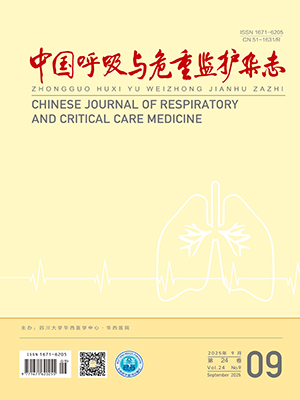| 1. |
Montesi Sydney B, Fisher Jolene H, Martinez Fernando J, et al. Update in interstitial lung disease 2019. Am J Respir Crit Care Med, 2020, 202: 500-507.
|
| 2. |
任涛, 唐以军, 王梅芳, 等. 弥漫性肺疾病70例临床报道. 中华保健医学杂志, 2019, 21(6): 535-538.
|
| 3. |
Periselneris J, Brown JS. A clinical approach to respiratory disease in patients with hematological malignancy, with a focus on respiratory infection. Med Mycol, 2019, 57(Supplement_3): S318-S327.
|
| 4. |
Nishino M, Itoh H, Hatabu H. A practical approach to high-resolution CT of diffuse lung disease. Eur J Radiol, 2014, 83(1): 6-19.
|
| 5. |
Drakopanagiotakis F, Paschalaki K, Abu-Hijleh M, et al. Cryptogenic and secondary organizing pneumonia: clinical presentation, radiographic findings, treatment response, and prognosis. Chest, 2011, 139(4): 893-900.
|
| 6. |
Chan C, Fagarasanu AD, Reid A, et al. Organizing pneumonia associated with T-cell lymphoma. Respirol Case Rep, 2020, 8(9): e00677.
|
| 7. |
Cordier JF. Organising pneumonia. Thorax, 2000, 55(4): 318-328.
|
| 8. |
Asano T, Fujii N, Niiya D, et al. Complete resolution of steroid-resistant organizing pneumonia associated with myelodysplastic syndrome following allogeneic hematopoietic cell transplantation. Springerplus, 2014, 3: 3.
|
| 9. |
Yamamoto M, Murata K, Kiriu T, et al. Acute fibrinous and organizing pneumonia with myelodysplastic syndrome: corticosteroid monotherapy led to successful ventilator weaning. Intern Med, 2016, 55(21): 3155-3159.
|
| 10. |
Vasu TS, Cavallazzi R, Hirani A, et al. A 64-year-old male with fever and persistent lung infiltrate. Respir Care, 2009, 54(9): 1263-1265.
|
| 11. |
Merrill AL, Smith H. Myelodysplastic syndrome and autoimmunity: a case report of an unusual presentation of myelodysplastic syndrome. Case Rep Hematol, 2011, 2011: 560106.
|
| 12. |
Nguyen LP, Ahdoot S, Sriratanaviriyakul N, et al. Acute fibrinous and organizing pneumonia associated with allogenic hematopoietic stem cell transplant successfully treated with corticosteroids: a two-patient case series. J Investig Med High Impact Case Rep, 2016, 4(2): 2324709616643990.
|
| 13. |
Ishii H, Tazawa R, Kaneko C, et al. Clinical features of secondary pulmonary alveolar proteinosis: pre-mortem cases in Japan. Eur Respir J, 2011, 37(2): 465-468.
|
| 14. |
Milani P, Basset M, Russo F, et al. The lung in amyloidosis. Eur Respir Rev, 2017, 26(145): 170046.
|
| 15. |
Liu Y, Jin Z, Zhang H, et al. Diffuse parenchymal pulmonary amyloidosis associated with multiple myeloma: a case report and systematic review of the literature. BMC Cancer, 2018, 18(1): 802.
|
| 16. |
Higo H, Fujiwara K, Watanabe H, et al. Diffuse parenchymal pulmonary amyloidosis showing an objective response to bortezomib-based chemotherapy. Intern Med, 2014, 53(16): 1809-1812.
|
| 17. |
Keklik F, Alrawi EB, Cao Q, et al. Diffuse alveolar hemorrhage is most often fatal and is affected by graft source, conditioning regimen toxicity, and engraftment kinetics. Haematologica, 2018, 103(12): 2109-2115.
|
| 18. |
Distefano G, Fanzone L, Palermo M, et al. HRCT patterns of drug-induced interstitial lung diseases: a review. Diagnostics (Basel), 2020, 10(4): 244.
|
| 19. |
Duarte AC, Cordeiro A, Fernandes BM, et al. Rituximab in connective tissue disease-associated interstitial lung disease. Clin Rheumatol, 2019, 38(7): 2001-2009.
|
| 20. |
Bergeron A, Bergot E, Vilela G, et al. Hypersensitivity pneumonitis related to imatinib mesylate. J Clin Oncol, 2002, 20: 4271-4272.
|
| 21. |
Guzelkucuk Z, Isık M, Ozcan AS, et al. Imatinib-related interstitial lung disease. Br J Haematol, 2018, 180(6): 780.
|




